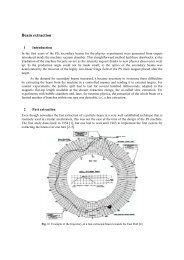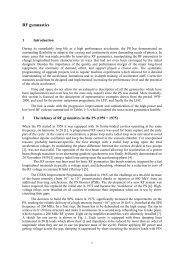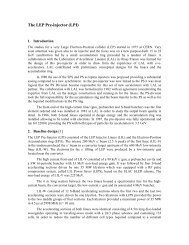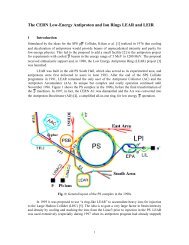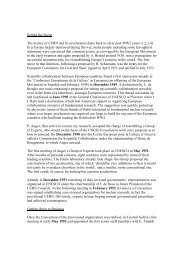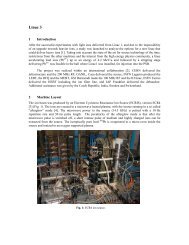The PS in the LEP injector chain - 50th anniversary of the CERN ...
The PS in the LEP injector chain - 50th anniversary of the CERN ...
The PS in the LEP injector chain - 50th anniversary of the CERN ...
You also want an ePaper? Increase the reach of your titles
YUMPU automatically turns print PDFs into web optimized ePapers that Google loves.
<strong>PS</strong> and for S<strong>PS</strong> <strong>in</strong>jection. To modify and control <strong>the</strong> damp<strong>in</strong>g partition, Rob<strong>in</strong>son wigglers had to be<br />
<strong>in</strong>stalled <strong>in</strong> <strong>the</strong> <strong>PS</strong>. S<strong>in</strong>ce <strong>the</strong> electron–positron emittances were smaller than <strong>the</strong> proton emittances, <strong>the</strong><br />
leptons could be accepted by <strong>the</strong> S<strong>PS</strong> at a fairly low energy <strong>of</strong> 3.5 GeV. However, to prevent<br />
<strong>in</strong>stabilities and beam losses, <strong>the</strong> total charge accelerated per pulse had to be spread over many<br />
bunches. This was <strong>the</strong> reason for choos<strong>in</strong>g eight bunches throughout <strong>the</strong> <strong>in</strong>jector cha<strong>in</strong> as <strong>the</strong> basic<br />
mode <strong>of</strong> operation.<br />
Next, <strong>the</strong> eight positron bunches were transferred to <strong>the</strong> S<strong>PS</strong> <strong>in</strong> two batches <strong>of</strong> four bunches<br />
(spaced by 30 ms) via <strong>the</strong> exist<strong>in</strong>g proton beam l<strong>in</strong>e TT10, and <strong>the</strong> eight electron bunches were<br />
similarly sent <strong>the</strong> S<strong>PS</strong> <strong>in</strong> two batches <strong>of</strong> four bunches through <strong>the</strong> past antiproton beam l<strong>in</strong>e TT70. <strong>The</strong><br />
leptons were orig<strong>in</strong>ally accelerated to 20 GeV <strong>in</strong> <strong>the</strong> S<strong>PS</strong> with an extra 200 MHz RF system consist<strong>in</strong>g<br />
<strong>of</strong> 32 s<strong>in</strong>gle-cell cavities and, after extraction <strong>the</strong> S<strong>PS</strong>, <strong>the</strong>y were sent to <strong>LEP</strong> via two new transfer<br />
l<strong>in</strong>es.<br />
<strong>The</strong> lepton beams were <strong>in</strong>jected <strong>in</strong> <strong>the</strong> arcs <strong>of</strong> <strong>LEP</strong>, where <strong>the</strong> dispersion function was non-zero.<br />
<strong>The</strong> circulat<strong>in</strong>g beam was brought close to <strong>the</strong> septum by means <strong>of</strong> a closed-orbit bump so that <strong>the</strong><br />
<strong>in</strong>com<strong>in</strong>g beam <strong>the</strong>n followed an orbit similar to and near to that <strong>of</strong> <strong>the</strong> circulat<strong>in</strong>g beam. So, <strong>the</strong><br />
<strong>in</strong>jected bunch could be stacked <strong>in</strong> ei<strong>the</strong>r betatron phase space (large-amplitude betatron oscillations<br />
about <strong>the</strong> central orbit <strong>in</strong>tegrat<strong>in</strong>g <strong>the</strong> stored beam density after synchrotron radiation damp<strong>in</strong>g) or<br />
synchrotron phase space (large-amplitude synchrotron oscillations about an <strong>of</strong>f-momentum orbit,<br />
reach<strong>in</strong>g <strong>the</strong> stored beam density after damp<strong>in</strong>g, as <strong>the</strong> dispersion function was non-zero at <strong>in</strong>jection<br />
and <strong>the</strong> <strong>in</strong>com<strong>in</strong>g lepton energy was a bit lower than <strong>the</strong> tuned <strong>LEP</strong> energy) next to <strong>the</strong> already<br />
circulat<strong>in</strong>g bunch <strong>of</strong> <strong>LEP</strong>. <strong>The</strong> same <strong>in</strong>jection equipment was used for both betatron and synchrotron<br />
phase space stack<strong>in</strong>g schemes, <strong>the</strong> preference among <strong>the</strong> two depend<strong>in</strong>g on <strong>the</strong> <strong>LEP</strong> operation mode.<br />
Quite wide-rang<strong>in</strong>g modifications had to be made to use <strong>the</strong> <strong>PS</strong> as a 3.5 GeV electron–positron<br />
synchrotron. Almost all <strong>the</strong> exist<strong>in</strong>g equipment <strong>of</strong> <strong>the</strong> <strong>PS</strong> mach<strong>in</strong>e was compatible with <strong>the</strong><br />
acceleration <strong>of</strong> electrons and positrons. However, <strong>the</strong> vacuum chamber was entirely changed; electron<br />
and positron transfer l<strong>in</strong>es from EPA to <strong>PS</strong> and <strong>in</strong>jections <strong>in</strong>to <strong>the</strong> <strong>PS</strong> were added. New 114 MHz RF<br />
cavities, Rob<strong>in</strong>son wiggler magnets, and some <strong>in</strong>strumentation were added too. <strong>The</strong> new <strong>in</strong>jection<br />
system was <strong>in</strong>stalled without compromis<strong>in</strong>g <strong>the</strong> performance with proton beams. <strong>The</strong> extraction<br />
channels were <strong>the</strong> same as for proton–antiproton operation. S<strong>in</strong>ce <strong>the</strong> <strong>PS</strong> is a comb<strong>in</strong>ed-function lattice<br />
synchrotron and has a long acceleration cycle, <strong>the</strong> implementation <strong>of</strong> Rob<strong>in</strong>son wigglers to ensure <strong>the</strong><br />
stability <strong>of</strong> <strong>the</strong> beams was essential. <strong>The</strong> wigglers also helped to match <strong>the</strong> longitud<strong>in</strong>al bunch size to<br />
<strong>the</strong> S<strong>PS</strong>.<br />
In 1986 leptons were <strong>in</strong>jected and accumulated <strong>in</strong> <strong>the</strong> EPA at 500 MeV <strong>in</strong>stead <strong>of</strong> 600 MeV as<br />
<strong>in</strong>itially planned. S<strong>in</strong>ce <strong>the</strong>n, 500 MeV rema<strong>in</strong>ed <strong>the</strong> nom<strong>in</strong>al lepton energy <strong>in</strong> EPA. First <strong>in</strong>jection <strong>in</strong><br />
<strong>the</strong> <strong>PS</strong> <strong>of</strong> electrons at 500 MeV and acceleration was achieved <strong>in</strong> 1986. By 1987 electron and positron<br />
beams were ready.<br />
2 Operat<strong>in</strong>g modes <strong>of</strong> <strong>the</strong> <strong>PS</strong> and S<strong>PS</strong> <strong>in</strong>jectors<br />
In <strong>the</strong> early years for <strong>the</strong> basic mode <strong>of</strong> operation <strong>the</strong> electrons or positrons were accelerated <strong>in</strong> <strong>the</strong><br />
dead-time <strong>of</strong> <strong>the</strong> S<strong>PS</strong>; but <strong>in</strong> place <strong>of</strong> one acceleration cycle, four 1.2 s lepton magnetic cycles were<br />
<strong>in</strong>serted between <strong>the</strong> proton cycles to decrease <strong>the</strong> <strong>in</strong>tensity <strong>of</strong> <strong>the</strong> lepton beams <strong>in</strong> <strong>the</strong> <strong>in</strong>jectors for<br />
beam stability reasons. Positrons were accelerated <strong>in</strong> <strong>the</strong> first two cycles and electrons <strong>in</strong> <strong>the</strong> second<br />
two, which led to <strong>the</strong> <strong>PS</strong> and S<strong>PS</strong> supercycle pattern {p e + e + e - e - }. Both <strong>LEP</strong> beams consisted <strong>of</strong> four<br />
bunches. Figure 2 shows <strong>the</strong> magnet supercycle <strong>of</strong> <strong>the</strong> S<strong>PS</strong> and <strong>PS</strong>, and <strong>the</strong> total beam <strong>in</strong>tensity <strong>in</strong> <strong>the</strong><br />
EPA. <strong>PS</strong> and S<strong>PS</strong> supercycles were made <strong>of</strong> various magnetic cycles, one or several cycles be<strong>in</strong>g<br />
allocated to each user [4].<br />
With<strong>in</strong> a S<strong>PS</strong> 14.4 s supercycle time period, <strong>the</strong> positrons were accumulated <strong>in</strong> <strong>the</strong> EPA dur<strong>in</strong>g<br />
<strong>the</strong> quite long S<strong>PS</strong> proton cycles due to <strong>the</strong> low positron <strong>in</strong>tensity <strong>of</strong> <strong>the</strong> l<strong>in</strong>ac (LIL-W). <strong>The</strong> l<strong>in</strong>ac<br />
2



